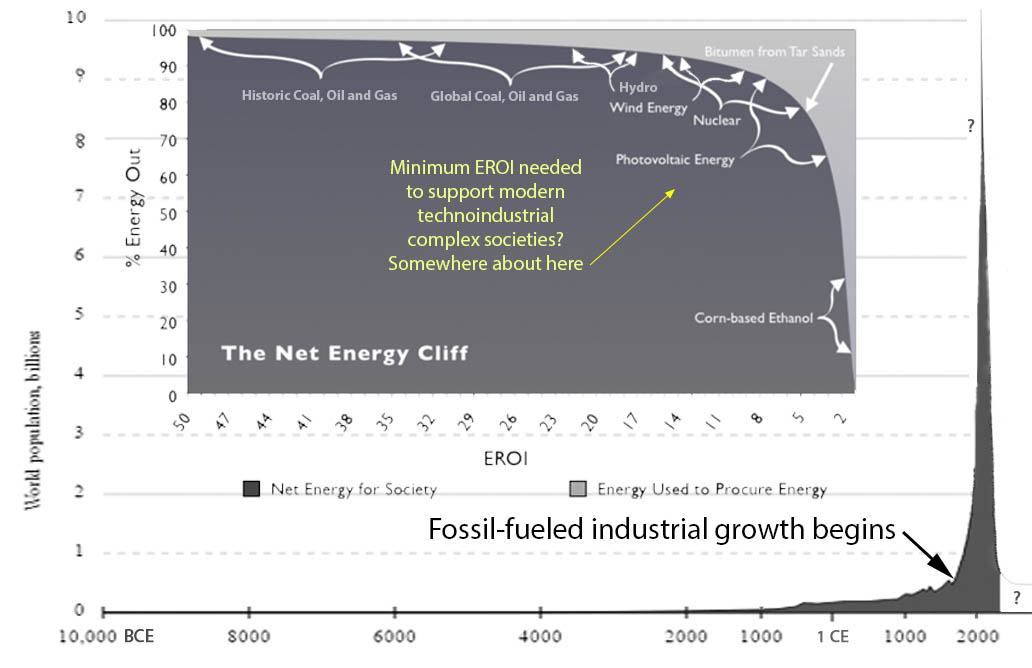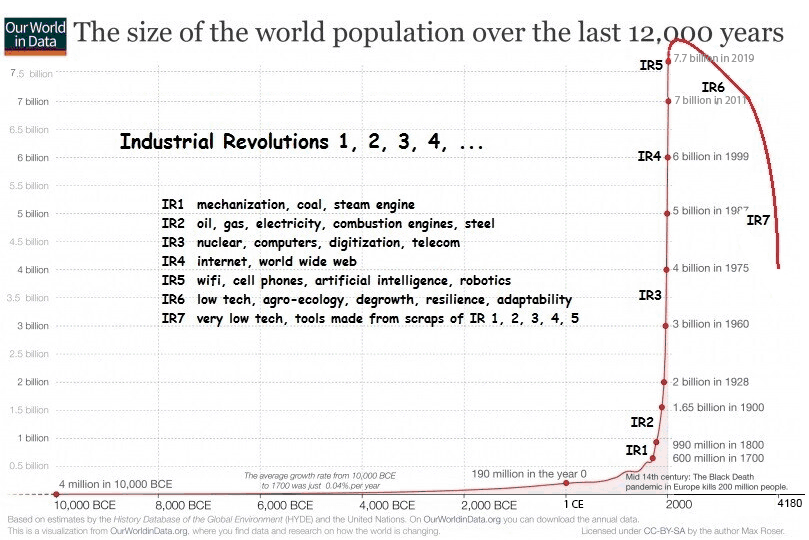
[may be delay fully loading large graphic]
SUNDAY, AUGUST 16, 2015: NOTE TO FILE

Human Population Curve
It's been a long way up
Eric Lee, A-SOCIATED PRESS
TOPICS: POPULATION, FROM THE WIRES, THE CURVE
Abstract: Another attempt to redress human temporal blindness (lacking temporal causal cohesion). A big picture look at the last 200,000 years, or recent history.
TUCSON (A-P) — Graphs can inform the numerate and yet fail to convey enormity. The following looks back in time and summarizes the history and prehistory of our species. The X axis only goes back 200,000 years even though Homo sapiens go back over 370,000 years, a blip in geological time. The Y axis indicates human population change over time, each tick marking 100,000,000 humans added. One hundred million added human lives, one tick, is an enormous number human minds cannot expect to grasp. If the graph were printed out, it would be 56 feet (17 meters) long. If that seems excessive, well, consider the subject. If each tick marked the number of humans one human can reasonably 'know', maybe 100, then the printout would be over 10,000 miles long, so the scale chosen cannot but fail to convey enormity.
Start at bottom and scroll up.
Until about 8,000 BCE, the growth of human populations added on average about seven humans per year to the planet. Between 8,000 BCE and 1700 CE, the Neolithic to the beginning of Industrial Revolution, about 50,000 humans were added each year. Since the fossil-fueled Industrial Revolution, about 15,000,000 humans were added per year, an 11-fold increase over 250 years, or about two million times faster than Paleolithic humans.
So since setting foot on the moon, human population has doubled and since today's centenarians were born it has quadrupled. The elders of today have seen an increase of five billion humans in their lifetime. It took 200,000 to 300,000 years (2,400,000 to 3,600,000 months) to add the first 100,000,000 people. Now, with the slowing of the population growth rate, it takes, thanks to continued "progress," less than 14 months to add another 100,000,000 people. But in the early 1960's it only took 7.5 months, so we're slacking off. It's starting to not look like progress anymore, so we need to redouble our efforts to keep on growing. Maybe ban birth control, abortion, criminalize homosexuality and masturbation everywhere, not just in the more progressive areas of the world.
A reasonable evidence-based best guess as to Earth's carrying capacity for humans, when not feeding off the immense trough of fossil fuels (for a time), would be less than 1 billion. Global population, at the start of the Industrial Revolution, was about 650,000,000, up from perhaps only 26,000 humans 1.2 million years ago. By about 40,000 years ago the human population had increased to about 3 million (the current size of the Denver metro area), and in a mere 30 thousand years it had increased to about 8 million prosperous people on the planet (less than currently live in the Chicago metro area). Nature's carrying capacity, sans fossil fuel inputs, has been substantially decreased since. The attempt to prolong the fossil-fueled pulse will further degrade Earth's carrying capacity for humans and the life-support system for all life, so 1 billion is a starry-eyed overestimate. For posterity to live a prosperous life without working in agricultural fields 12 hours a day average, more in summer (which does not exclude low-intensity agriculture) and without use of fossil fuels, imagine 40 million as maybe not too many for Earth's environmental productivity to support sustainably. But I could be wrong, maybe single digit millions is the right answer as only Nature has all the answers and can determine carrying capacity. Humans don't get a vote.
The human bottleneck conjecture is that about 70,000 years ago the ancestral population of all of today's humans numbered 3,000–10,000 "surviving" individuals. Some imagine the Toba Supervolcano supereruption of about 75,000 years ago caused an abrupt change in climate resulting in vast depopulation of humans and other species. Indeed, there is a consensus "that a supereruption of the scale at Toba must have led to very extensive ash-fall layers and injection of noxious gases into the atmosphere, with worldwide effects on weather and climate." But it didn't.
The change would have been far more rapid and dramatic than any anthropogenic climate change envisioned today, yet, like today, there is no consensus as to what change and what effect change had or will have on animal and plant populations, including humans. Many scientists, like everyone else, have believing minds and believe what they want. Some see no effect of Toba on human populations as supported by evidence (1 °C change). Others are certain that the bottleneck of humans and other primates and mammals after the Toba climate change event (15 °C change) caused near extinction of humans and other species, as supported by cherry-picked evidence.
Motivated science is common, as is motivated reasoning. The possibility that the apparent bottleneck event was a replacement event among anatomically modern humans that was caused by a non-anatomical mutation, memetic or genetic, within a small African population of Homo sapiens sapiens about 70,000 years ago such that they spread forth as conquers/expansionists/supremacists to replace other anatomically modern humans as well as Denisovan, Neanderthal, and all other hominins (likely H. floresiensis and H. luzonensis), just can't be true as such a theory doesn't feel good, so is unpopular, especially on social media.
Viewing climate change as a politicized bit of data, as the only reason we have to worry about near-term human extinction (or not), is popular among the left leaning on social media and among some academics. If there had been social media 75,000 years ago, the Toba eruption would have been all the prattle, for a time. If the left leaning tend to make me facepalm, it is not because I'm right leaning as the right leaning typically don't know enough to have an opinion, so I'm less likely to be exposed to their prattle. When humans attempt to think about humans, expect bad science, bad thinking, and "controversy," i.e. endless prattle. On the "bottleneck event" vs "replacement event" spectrum, misanthropes would insist on the replacement event being "true," perhaps yelling and shaking their fists unless they were academics at a conference where mere eloquence works best along with motivated interpretation of data.
The way down to <1 billion will resemble the way up. In 100 years the way down will not move the red line above to the right by one pixel and so will not be noticeable. The question is where will the population be in 1000 years as it barely moves the red line to the right and how far up will the red line have reached? No prize will be given if we reach 8 billion, 9 billion, 10 billion, or 11 billion, as the higher the red line goes, the greater the loss of carrying capacity, and the lower the red line will emerge assuming it doesn't terminate at zero.

The above projection suggests a bell-shaped future (could well be shark-finned) in which decline to 1 billion occurs in 2250 CE. Could all humans be extinct, as shown, by 2300 CE? Could a remnant population survive because they had more ammo in their bug-out bunker than others? Do complex societies that collapse (all so far with one possible exception) typically lose 90-100 percent of their accumulated learning? Could there be a 100 percent loss of information that we of the first and last global empire have accumulated? Is an across the board loss of all we've learned and that we have recovered from all prior complex societies actually possible (i.e. no literate, numerate, or ecolate human survives)?
If we fail to preserve information packages and reverse our collective loss of functional behaviors, is there close to zero possibility that survivors (or some other species that may evolve) will recover the loss by rediscovery before Sol goes red giant? Could a remnant population, who had embraced descent, voted with their feet and agreed to 'seek out the condition now that will come anyway, but by our service be our biosphere's handmaiden anew', inherit the future? Is it possible that someday 'we'll have a human on the planet that really does understand it and can live with it properly'? The answer is likely yes (or no) to all. You can pick, but realize Nature doesn't care what you think.
The rate of decline could be steeper. No biophysical laws of the universe would be violated if humans were extinct by 2100. A more optimistic, if less likely future, could involve a more gradual descent. The following projection envisions a population peak of a bit over 8 billion in 2280 followed by a descent to 4 billion in 4180 CE. The exact point of climax and rate of descent is unpredictable in the same sense that the exact moment a car that never stops at a gas station runs out of gas cannot be predicted. But that overshoot implies descent and that a driven unrefueled car will stop is a given.

Of course there will be cold fusion, zero-point energy, some rabbit will be pulled from the technological hat. We will decouple from nature and carrying capacity will be irrelevant. No one will ask, "And then what?" or need to. The lithosphere will be hollowed out, the land developed in kilometers deep high-rises from former sea to non-shining sea as the oceans will be covered with floating cities. Life on Earth, thanks to the entertainment value of some, will be happily living in natural looking preserves formerly known as zoos.
Or not.
The story doesn't begin 200,000 years ago, of course. See "Human Origins in Deep Time" for the prior 5 billion years.

